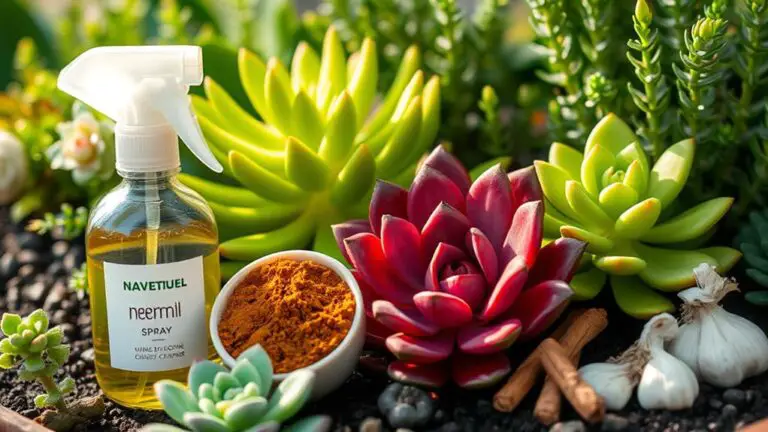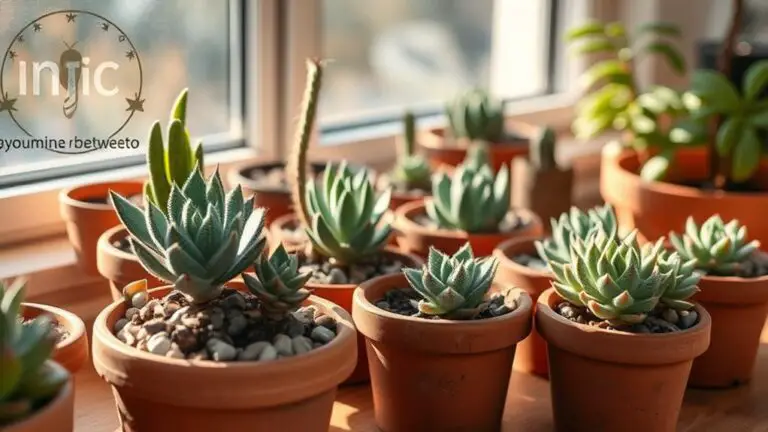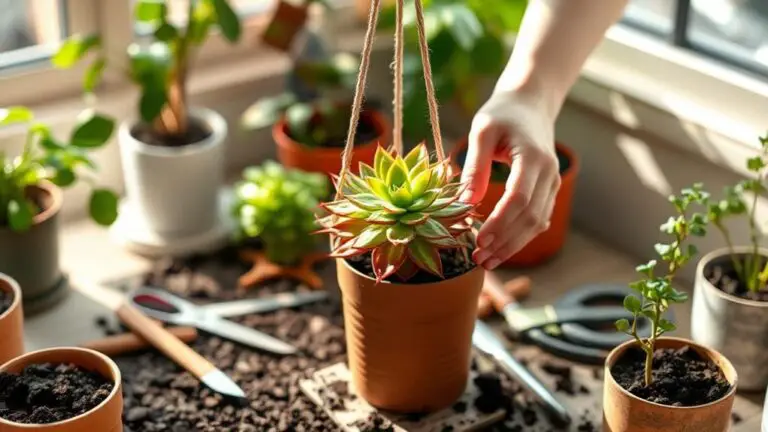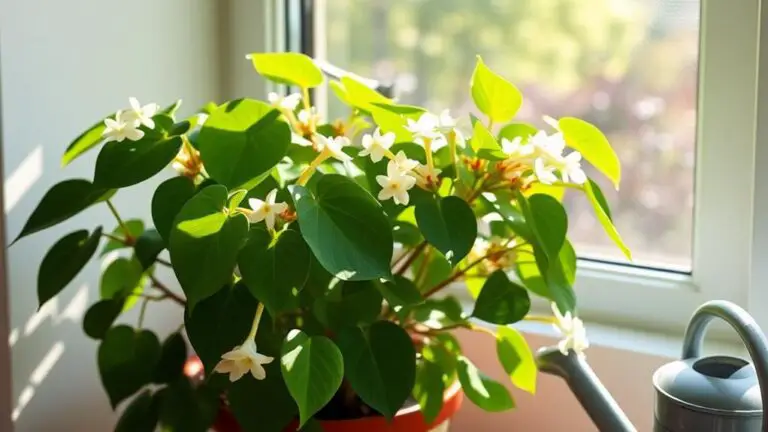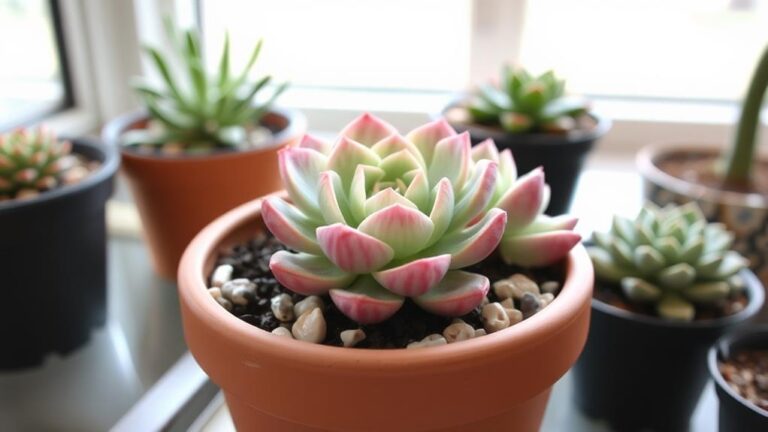Complete Guide to Echeveria Violet Queen Care
If you're aiming to master the intricacies of Echeveria Violet Queen care, you've come to the right place. This succulent demands bright, indirect sunlight and well-draining soil to thrive, but that's just the beginning. Imagine your plant flourishing with the right watering schedule, seasonal fertilization, and ideal temperature. Curious about avoiding common pitfalls like root rot or how to handle repotting? There's a lot more to explore to guarantee your Echeveria Violet Queen remains vibrant and healthy, ready to be a stunning addition to your plant collection.
Light Requirements

Echeveria Violet Queen thrives best with a minimum of 6 hours of bright, indirect sunlight each day to maintain its compact rosette shape. Ensuring your plant gets adequate light is essential for its health and beauty. Without enough light, the Echeveria can become leggy and lose its signature form.
You want to place it where it can enjoy bright sunlight to maintain its shape, like on a sunny windowsill or in a spot that gets dappled sunlight.
However, be careful not to expose it to too much direct sunlight. Excessive direct light can cause sunburn on the leaves, leading to brown or white patches. To avoid this, make sure the light is indirect yet bright.
When adapting your Echeveria to brighter light, gradual acclimatization is key. Sudden changes can shock the plant, so increase its light exposure slowly over a week or two.
Watering Needs
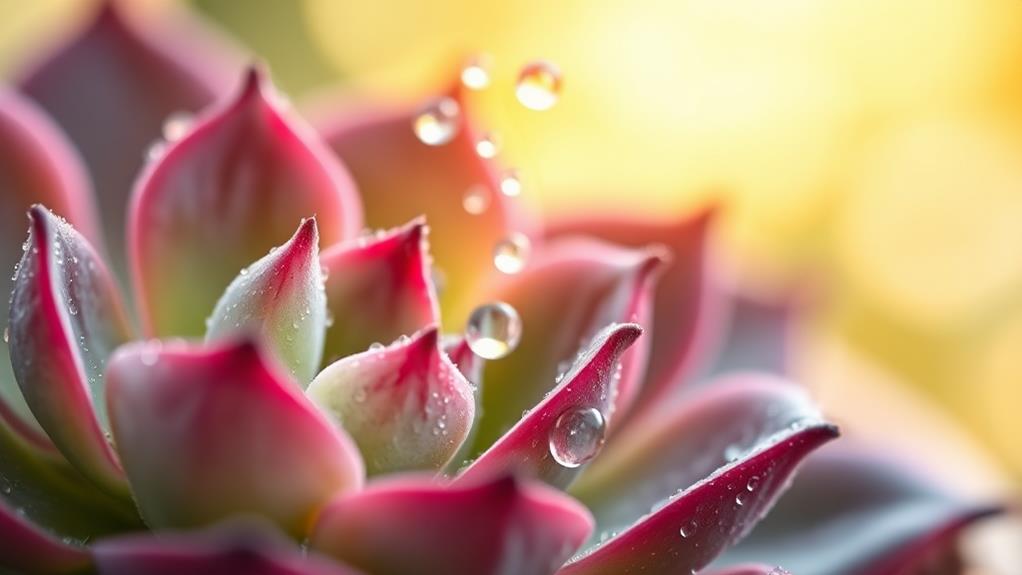
When it comes to watering needs, the key is to let the soil dry out completely between waterings. Echeveria Violet Queen thrives best with this approach. Typically, you'll want to water it every 1-2 weeks during the growing season.
Before you water, check the soil moisture by inserting your finger about an inch deep. Water only when the top inch feels dry. This practice helps to prevent root rot, which can be a major issue if the soil stays too wet.
Overwatering is more harmful than underwatering for your Echeveria. If you notice translucent, soft leaves, it's a sign you've watered too much. To avoid this, use well-draining soil, like a succulent or cactus potting mix. This type of soil helps water drain quickly, preventing it from accumulating around the plant's roots and in its rosette.
During the dormant seasons—fall and winter—reduce your watering frequency considerably. Let the soil dry out for longer periods before adding more water. This adjustment helps your plant rest and prevents rot during its slower growth phases.
Soil and Fertilization
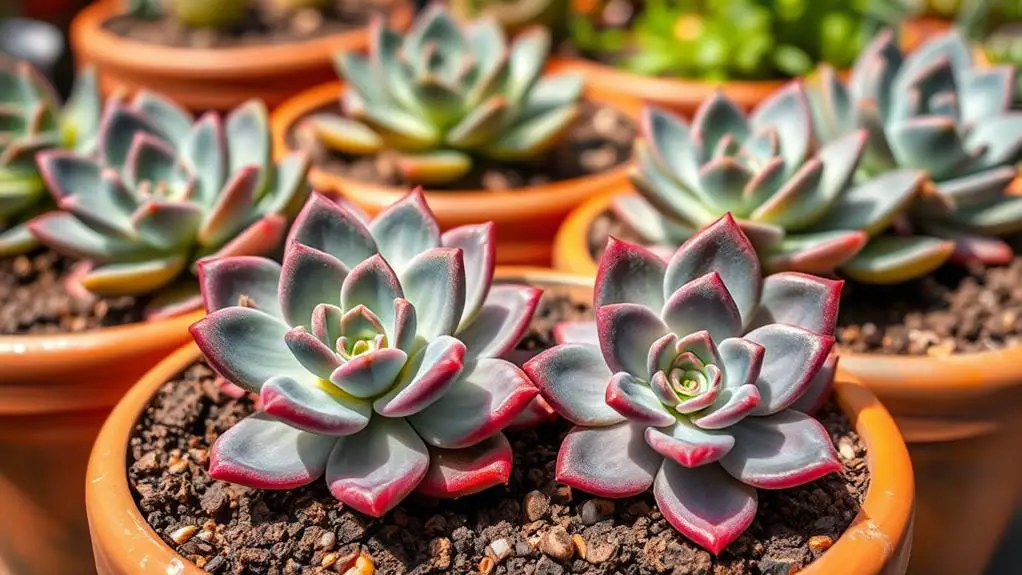
After mastering the watering needs, let's move on to the soil and fertilization requirements for your Echeveria Violet Queen.
This succulent thrives in well-draining soil, so choose a cactus or succulent potting mix. For the best results, make certain the mix contains 50%-70% mineral grit like sand, pumice, or perlite. This combination guarantees ideal drainage, which is vital for preventing root rot.
It's important to let the soil dry completely between waterings. Echeveria prefers infrequent watering rather than consistently moist conditions, so always check the moisture level. You can use a moisture meter or simply insert your finger about an inch deep into the soil to see if it's dry.
When it comes to fertilization, your Echeveria Violet Queen needs a bit of extra care during its active growing season, which is spring and summer.
Use a balanced, water-soluble fertilizer with lower nitrogen content to support healthy growth. Fertilize sparingly to avoid nutrient buildup.
During fall and winter, your plant goes dormant, so avoid fertilizing during these months to prevent stress.
Temperature and Humidity
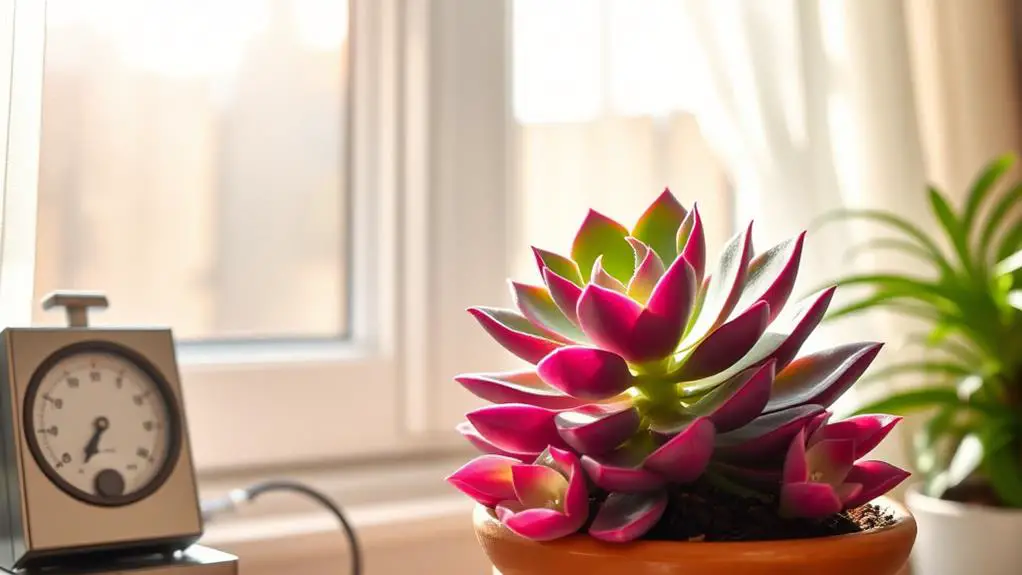
Maintaining the right temperature and humidity is essential for the health of your Echeveria Violet Queen. This succulent thrives in moderate to warm temperatures, ideally between 65°F to 75°F.
It's important to protect your plant from frost and freezing temperatures, as exposure can cause discoloration or even death. If you live in USDA hardiness zones 9-11, your Echeveria Violet Queen should be fine outdoors most of the year. However, during colder months, you'll need to bring it indoors.
When it comes to humidity, this plant prefers dry conditions. Indoor humidity levels between 30-50% are generally acceptable, but watch out for high humidity, which can lead to fungal issues.
To care for Echeveria Violet properly, make sure it's in a well-ventilated area. Good airflow helps prevent problems related to excessive moisture.
Here are three key tips for maintaining the right conditions:
- Monitor Temperatures: Keep the temperature between 65°F and 75°F, and avoid frost.
- Control Humidity: Aim for 30-50% humidity, and avoid overly humid environments.
- Ensure Ventilation: Place your plant in a well-ventilated area to promote healthy growth.
Potting and Repotting
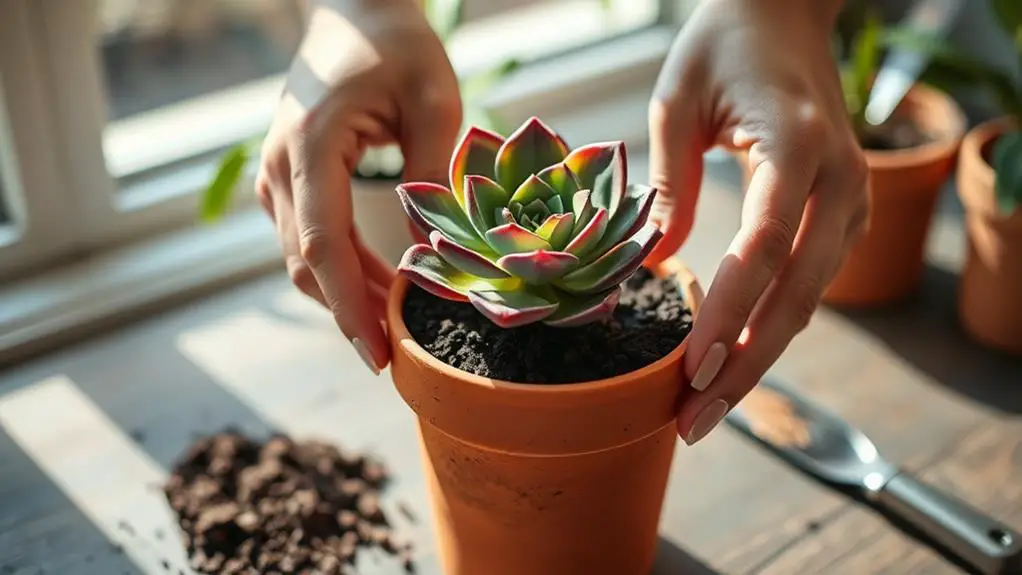
Proper potting and repotting are essential for the health of your Echeveria Violet Queen. Start by choosing a pot with drainage holes. This helps prevent water from pooling at the bottom and causing root rot.
Terracotta or ceramic pots are great options as they promote airflow and prevent water retention. Use a well-draining succulent or cactus potting mix. Ideally, this mix should contain 50% to 70% mineral grit, like sand, pumice, or perlite, to guarantee proper drainage.
You'll need to repot your Echeveria Violet Queen when it becomes root-bound, usually every 1-2 years if the plant is young. Signs that your plant is root-bound include roots protruding from the drainage holes.
The best time to repot is during the active growing season, which is in spring or summer. This minimizes stress and helps the plant establish itself in its new pot more easily.
When repotting, handle the roots gently to avoid damage. Choose a new pot that fits snugly around the root system but provides a bit of extra room for growth.
Confirming these steps will keep your Echeveria Violet Queen thriving and beautiful.
Frequently Asked Questions
How Do You Take Care of a Violet Queen Succulent?
To care for your Violet Queen succulent, give it 6 hours of bright, indirect sunlight daily. Water every 1-2 weeks, use well-draining soil, fertilize during growing season, and check for pests regularly.
How Do You Care for Echeveria Purple Succulents?
To care for Echeveria Purple succulents, provide bright, indirect sunlight for at least 6 hours daily. Water every 1-2 weeks, letting soil dry out completely. Use well-draining soil, maintain moderate temperatures, and prune dead leaves regularly.
How Do You Propagate Violet Queen Succulents?
To propagate Violet Queen succulents, use leaf cuttings or offsets. Let leaf cuttings callous for a day, then plant in well-draining soil. Twist off offsets and pot them. Place in indirect sunlight and mist occasionally.
How Do I Keep My Echeveria From Getting Leggy?
Make certain your Echeveria Violet Queen gets at least 6 hours of bright, indirect sunlight daily. Rotate it regularly for even light exposure, don't overwater, and prune leggy stems to encourage bushier growth and dense foliage.
Conclusion
Caring for your Echeveria Violet Queen is easy if you follow a few simple steps. Give it bright, indirect light, and let the soil dry out between waterings. Use well-draining soil and keep it in temperatures between 65°F and 75°F. Repot every 1-2 years, and fertilize sparingly in spring and summer. With these tips, your plant will thrive. Don't worry—you've got this, and your Echeveria will reward you with its beautiful growth!


